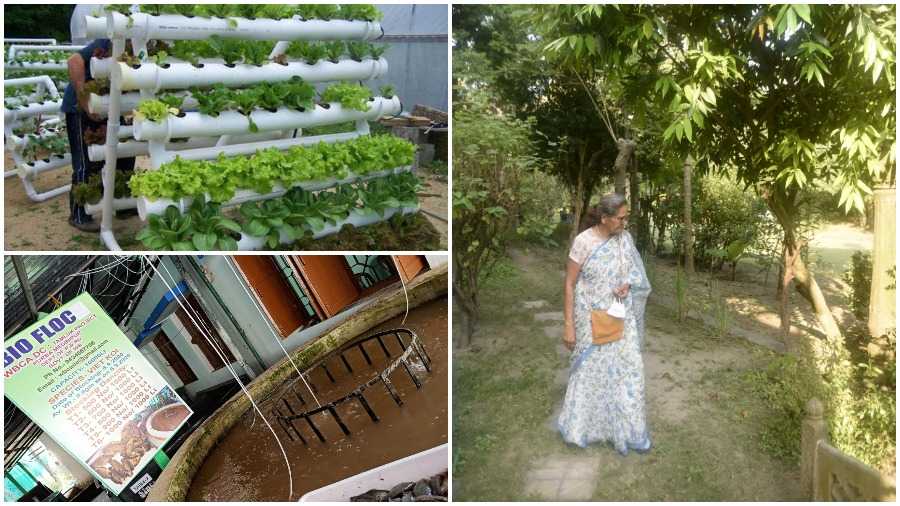The farm to table movement is no longer a fad but an earnest enterprise. In an urbanscape, however, land is scarce and that is why efforts are on to grow vegetables in vertical gardens or hanging seed beds and bioflocs are being used to rear fish.
The West Bengal Comprehensive Area Development Corporation, under the panchayat and rural development department of the state government, has started growing vegetables in vertical gardens and hanging seed beds at its headquarters in Mrittika Bhavan in Salt Lake, Calcutta.
Hanging seed beds are nothing but machas or bamboo structures that have three or four tiers on which jute sheets with six-inch or eight-inch soil layers are spread. Seeds are planted in the soil under controlled temperature with shade nets to avoid direct sunlight and rain. Sprinklers are used to irrigate the saplings.
Vegetables such as cucumber, pointed gourd, bottle gourd, pumpkin — mainly creepers — are grown in vertical gardens. “Many housing estates have approached us to understand how vertical gardens can be grown,” says Soumyajit Das, who is special secretary, panchayat and rural development.
Das adds, “We have reared fish worth Rs 39,000 in a 500-litre biofloc.” Bioflocs are artificial water bodies created using large poly sheets in which water mixed with probiotics form the phytoplank. The waterbody can hold anything between 500 and 30,000 litres of water. According to Das, efforts are also on to grow plants without soil, the technical name for which is hydroponic culture. Hydroponic plants grow only in water fortified with nutrients.
Botanist Basant Kumar Singh says these techniques are the need of the hour for cities. Propagating hydroponic cultivation, nature enthusiast Md Jawaid Alam of Patna says, “It is possible to grow plants without soil, sun, space and manpower. All you need is a leak-proof container filled with sand and stones, a leafy shoot, water and a plant nutrient.” Alam has developed his own fertiliser, which he has commercialised. His friend Sandip Kumar, who works in the ministry of skill development, grows hydroponic plants on his dining table. “I have pudina, dhania, mirchi growing on my dining table,” he says. Kumar also grows vegetables on his terrace — tomatoes, bottle gourds and pumpkins. “I have my own supply of vegetables,” he adds.
But there is a lucky handful who have their gardens in the heart of the city. Lata Bajoria of the Hooghly Jute Mills has been practising organic farming at her sprawling two-and-a-half acre garden in Garden Reach. The garden grows a variety of basil, cinnamon, cloves, Jamaican pepper, asafoetida, moringa, camphor. She also grows vegetables such as yam, chives, cauliflower, eggplant, radish; fruit trees such as passion fruit and avocado; medicinal plants such as mahabhringaraj and gulancha or giloy. “I don’t plant ornamental trees. Every tree in this garden has a use,” says Bajoria.
Somnath Dasgupta grows his veggies on a one-cottah plot adjoining his two-storey house in Rampur on Budge Budge Trunk Road. His grandfather, who bought the land in the 1950s, had experimented with paddy for a few seasons. Dasgupta has planted spinach, coriander, cauliflowers, brinjals and tomatoes. Last year, he planted beans and lal shaak (red amaranth).
Dasgupta has a gardener who comes in every other day to tend to the patch. He also has a four-cottah pond that yields 15 kilos of fish every two to three months — rohu, catla, mrigel, silver carp. “My fisherman releases fingerlings once a quarter,” says Dasgupta, who converted his flower garden into a vegetable garden a couple of years ago.
Last year, planting was delayed because the Covid-19 situation made it difficult to go to the haat to buy the seeds, and the soil remained wet longer. But apart from the fact that the rats attacked the cauliflowers, the greens did well. “This general area was marshy and they raised the height of the main road while building the Sampriti flyover. As a result my plot has become low-lying and gets waterlogged very easily,” Dasgupta complains. He has had to pile more earth to grow his greens.
Says Dasgupta, “I am definitely not self-sufficient in terms of my daily supplies. I still have to buy potatoes, onions, ginger and garlic from the bazaar as also my poultry supplies. But otherwise I make do with whatever I grow.”
Enough to turn green living things other than the foliage, no?











